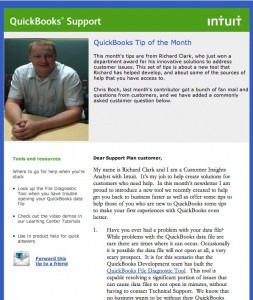When it comes to web services, Quickbooks gets it. They understand that the work begins after the sale, not leading up to it.
I recently had the opportunity to attend the RIS Media conference. There was a room full of vendors barking about the promised land that would be achieved magically through the adoption of thier products – generate more leads, track this, engage consumers this way, reduce costs here. In preparation for my panel address to the audience, I asked each booth to talk to me about thier support and training services. What happens after the sale?
The responses were dim – in some cases, dark. Clearly they were not prepared to answer such questions –
Today, as a Quickbooks user, I received my monthly “how to” newsletter. You see Intuit, like most world class web service companies takes a careful look at their call center. They group calls into categories and create a feedback loop to the product managers, developers and other product stakeholders. They use the customer newsletter as a training tool. Have a look.
 This Quickbooks newsletter addresses two clear goals. The first is to help customers who are in panic mode – complete system failure – they cannot open thier Quickbooks folder. This is a high priority call center call, but probably not the most frequent call.
This Quickbooks newsletter addresses two clear goals. The first is to help customers who are in panic mode – complete system failure – they cannot open thier Quickbooks folder. This is a high priority call center call, but probably not the most frequent call.
From there they go on to talking about less emergent issues, like scheduled backups. They also link to thier support and training videos. I have always been a fan of linking the videos directly from the area in the software where customers get stuck rather than sending customers on a search and find mission when they run into an issue. Perhaps the best answer is a combination of the two.
In any case, if you are looking for a new vendor, spend more time talking about training and support than the product features, advantages and benefits. Learn how the company is going to help you and your organization utilitize the technology tool to get the results the sales presentation promices. The best tools in the world are absolutely useless if they are not used correctly, or misused.




